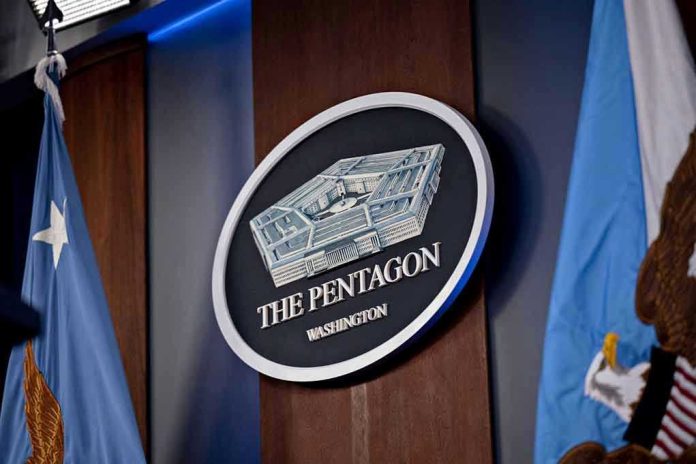
America’s missile arsenal, once the envy of the world, now faces a race against time, as Pentagon officials sound alarms over China’s military surge and depleted U.S. stockpiles.
Story Snapshot
- The Pentagon demands a two- to four-fold increase in missile production, citing fears of a near-term war with China.
- U.S. stockpiles are critically low after years of supplying Ukraine and Israel, putting American readiness in question.
- Defense contractors express skepticism, citing manufacturing bottlenecks and a lack of firm government funding.
- Industry experts warn the push may trigger a new global arms race and reveal deep vulnerabilities in U.S. manufacturing.
Pentagon Sounds the Alarm Over China
Top Pentagon officials convened a high-stakes roundtable with America’s leading missile manufacturers. Their message: U.S. missile inventories, especially the Patriot air defense and long-range anti-ship systems, have plummeted to dangerous lows. Recent conflicts in Ukraine and Israel drained supplies at an unprecedented pace. Meanwhile, China’s military buildup—marked by a rapid expansion of missile and nuclear forces—has shifted Washington’s strategic calculus, making a major conflict seem less theoretical and more imminent. The Pentagon now wants suppliers to deliver up to four times their usual output—an ambitious ask that reveals deep anxiety about America’s ability to deter or withstand a future peer conflict.
The urgency is not lost on policymakers. September saw the Army award Lockheed Martin a nearly $10 billion contract to produce roughly 2,000 PAC-3 missiles over just two years. Weekly meetings between the Pentagon and defense industry leaders have become the new normal, with the Munitions Acceleration Council—chaired by Deputy Secretary Stephen Feinberg—tasked with breaking bottlenecks and accelerating plans. Some officials, including President Trump and Secretary Pete Hegseth, are exploring extraordinary measures to meet the surge targets. Yet, despite the headlines and historic contracts, a growing chorus within the industry warns that doubling or quadrupling output may simply not be possible without concrete funding guarantees and fundamental changes to America’s industrial base.
Manufacturing Challenges Threaten Missile Surge
Defense contractors, including Lockheed Martin and Raytheon, are racing to expand facilities and recruit skilled labor. Their skepticism is palpable. Executives argue that the Pentagon’s demands exceed the current capacity of American manufacturing, already stretched thin by global supply chain disruptions and rising demand from allies. Industry officials openly question the realism of the targets, pointing to past wartime surges—like those in WWII and the Cold War—when America’s industrial base was far larger and more flexible. Today, the U.S. faces a “just-in-time” production ecosystem, where component shortages and slow ramp-up times threaten to derail even the most ambitious plans. Contractor investment remains cautious, hinging on whether Washington will commit long-term funding rather than short-term fixes.
The stakes extend far beyond the factory floor. U.S. missile stockpiles, according to multiple sources, are at just 25% of required levels for the Patriot system—well below what Pentagon strategists consider prudent in the face of a rising Chinese threat. Global demand for advanced missile systems has surged, with allies scrambling to secure contracts and the U.S. carrying the bulk of the burden due to the absence of European equivalents. The race to replenish stockpiles and expand production capacity has exposed deep vulnerabilities in America’s defense sector, raising uncomfortable questions about the country’s ability to respond to simultaneous crises or sustain a prolonged conflict.
Geopolitical and Economic Ripple Effects
The Pentagon’s campaign to boost missile production carries profound geopolitical and economic implications. In the short term, billions in new contracts promise job growth and a potential renaissance for the defense sector. Yet, the pressure on supply chains and labor pools is mounting, with analysts warning of delays and bottlenecks if government funding and industrial capacity do not align. The specter of an arms race looms large, as China’s military modernization continues apace and U.S. efforts to stay ahead threaten to spark escalation. Socially, the rush to rearm has heightened public anxiety over the risks of war and the readiness of America’s military forces, fueling political debate about priorities and national security strategy.
Industry experts and academics offer a sobering assessment. The Pentagon’s push is seen as a reflection of deep-seated fears about losing military advantage to China. Professor Shen Yi of Fudan University calls the targets “unrealistic,” highlighting systemic issues in U.S. manufacturing. Analysts argue that the production surge is not only about replenishing depleted stockpiles, but also about capitalizing on global demand for advanced weapons. Diverse viewpoints persist: some view the missile surge as a necessary deterrent; others fear it will only fuel an expensive and destabilizing arms race, risking miscalculation and overestimating the immediacy of the China threat.
Sources:
Global Times: Pentagon Urges Suppliers To Massively Boost Missile Production Amid China War Fears
Defense Mirror: U.S. to Increase Missile Production for Possible Conflict with China







